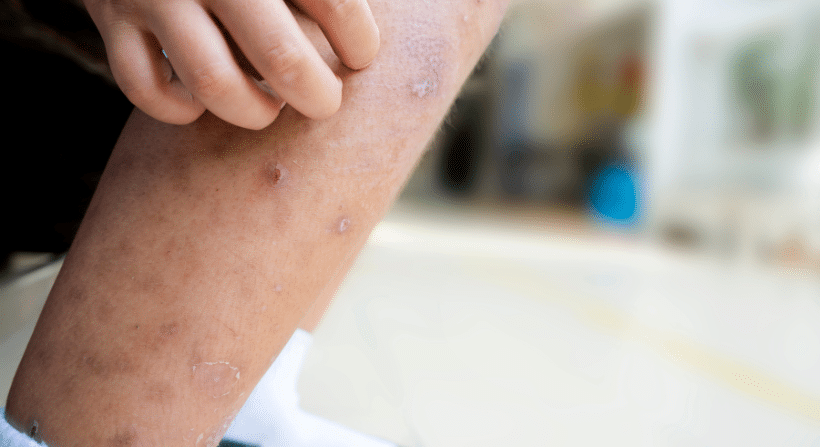Dealing with bed bugs and their bites can be a distressing and overwhelming experience. These tiny, elusive pests can quickly turn your home into an uncomfortable environment, causing sleepless nights and anxiety. Bed bug bites often lead to itching, redness, and irritation, adding to the frustration of managing an infestation. In this blog, we’ll explore effective strategies for dealing with bed bugs and treating their bites. From identifying the signs of an infestation to implementing comprehensive control measures and soothing bite symptoms, we’ll provide you with the information and resources you need to tackle this challenging problem.

With the right approach, you can reclaim your home and peace of mind from these persistent pests.
1. Understanding Bed Bugs
Bed bugs (Cimex lectularius) are small, flat, reddish-brown insects that feed on the blood of humans and animals. They are mainly active at night and are attracted to warmth and carbon dioxide emitted by their hosts. Bed bugs can hide in various cracks and crevices, making them difficult to detect.
2. Identifying Bed Bug Bites
Bed bug bites typically appear as small, itchy, red welts that are often grouped together in a linear or zigzag pattern. However, it’s important to note that reactions to bed bug bites can vary from person to person. Some individuals might not show any visible signs of bites, while others could experience more severe reactions, including blisters or hives.
3. Distinguishing Bed Bug Bites from Other Insect Bites
Bed bug bites can be mistaken for bites from other insects, such as mosquitoes or fleas. Unlike mosquito bites, bed bug bites often appear in clusters or lines. Additionally, bed bug bites tend to be more persistent and might not show immediate swelling like mosquito bites.
4. Preventing Bed Bug Infestations
Prevention is key when it comes to bed bugs. To minimize the risk of an infestation:
Regularly inspect your sleeping area, including the mattress, box spring, and headboard.
Vacuum your living space frequently, paying close attention to cracks, crevices, and seams.
Use protective mattress and pillow covers designed to prevent bed bugs from infesting these items.
Be cautious when acquiring second-hand furniture, especially mattresses and upholstered items.
5. Detecting Bed Bug Infestations
Early detection is essential in controlling bed bug infestations. Look out for the following signs:
Rusty or reddish stains on bedding or mattresses caused by crushed bed bugs.
Tiny, pale yellow eggs or eggshells in crevices or seams.
Tiny, shed bed bug skins that are translucent.
Fecal spots, which appear as small dark spots on bedding, mattresses, or walls.
6. Treating Bed Bug Bites
If you’re bitten by bed bugs, there are steps you can take to alleviate discomfort:
Wash the affected area gently with soap and water.
Apply a cold compress to reduce itching and inflammation.
Over-the-counter creams or ointments containing hydrocortisone can help relieve itching.
Avoid scratching the bites, as it can lead to infection.
7. Getting Rid of Bed Bugs
Complete eradication of bed bugs can be challenging and might require professional assistance. Some steps you can take include:
Thoroughly cleaning and decluttering your living space.
Washing infested bedding, linens, and clothing in hot water.
Using a vacuum with a HEPA filter to vacuum cracks, crevices, and other hiding spots.
Applying insecticides or hiring a professional exterminator to treat infested areas.
8. Psychological Impact
Dealing with a bed bug infestation can take a toll on your mental well-being. The fear of bites and the stigma associated with infestations can cause anxiety and stress. Seeking support from friends, family, or a mental health professional can help you cope with these challenges.
9. Traveling and Bed Bug Prevention
Bed bugs can easily hitch a ride on luggage or clothing, making travelers susceptible to infestations. To reduce the risk:
Inspect hotel rooms for signs of bed bugs before settling in.
Keep luggage elevated and away from beds and upholstered furniture.
Upon returning home, wash and dry all clothing on high heat to kill any potential bed bugs.
Read Also: Bed Bugs: Frequently Asked Questions
Conclusion
Bed bugs and bed bug bites can be distressing, but with proper knowledge and proactive measures, you can minimize the risk of infestations and effectively manage any encounters. Regular inspections, cleanliness, and vigilance are your best tools in the battle against these resilient pests. If an infestation becomes overwhelming, seeking professional help is a prudent step toward restoring your peace of mind and your home’s comfort.
If you’re struggling with a bed bug infestation and need professional assistance, don’t hesitate to contact Tulsa Bed Bug Exterminator. Our experienced team offers expert solutions tailored to your needs, helping you reclaim your home from bed bugs. Schedule a consultation today and take the first step towards a bed bug-free home.

Recent Comments